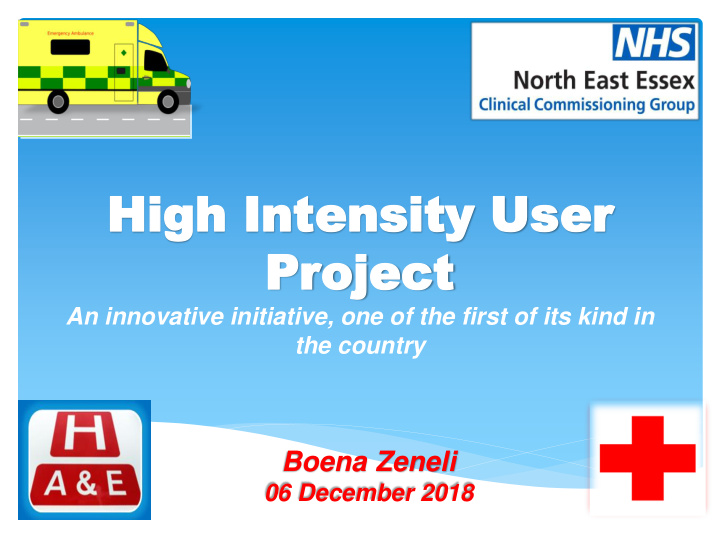



High Inten High Intensity sity User User Pr Project oject An innovative initiative, one of the first of its kind in the country Boena Zeneli 06 December 2018
Our ambition Our ambition To ensure that ‘High Intensity Users’ – those who engage with urgent & emergency services inappropriately, are supported to access the right care , in the right place at the right time . To thereby, meet unmet patients needs and improve patients’ and staff’ experiences and to create capacity and make financial savings.
Outcome Outcome The number of ambulances dispatched, A&E attendances and admissions all decreased on average by 36% Patient receive the right health care and the clinical as well as non clinical needs are met Staff are happier and better supported to make complex decisions Potential savings of £48,230 were identified for the pilot. For the expanded project, average savings per patient of £2,613.56 , with a total saving of £122,837.32
Impact and In Impact and Involv olvement ement The pilot began in 2015 with a focus on three patients, and due to its success , a larger scale project was agreed This expanded project has resulted in significant achievements . Over a period of 12 months, 5 HIUs have called the Ambulance service 1,196 times between them but our project enabled the Ambulance Service to only send an ambulance on 199 occasions
Impact and Involv Impact and In olvement ement cont cont … By discussing HIUs via our multi-disciplinary team approach (MDT) in a holistic way, we have improved integration across the health economy, including: acute, ambulance, mental health, community, 111 and OOH services In addition, there is regular collaboration with social care, voluntary services, the police and the borough councils Both behavioural changes among HIUs and financial savings as well as better working environment have led to a more efficient and effective service for the patients we serve
Ho How w we lear e learned an ned and sh d shar ared ed our e our experience xperience We consulted for advice with a number of organisations including the London Ambulance Service and learned from Blackpool CCG model We have helped Ipswich and East Suffolk and West Suffolk CCGs who are part of our STP footprint We have been contacted by Mid Essex CCG, Bromley CCG, West Essex CCG, Chiltern CCG and Aylesbury CCG who have appreciated our help We have also published an article on NHSI (Academy of Fabulous Stuff), presented for EdgeTalks, We have been contacted by our local Right Care lead and asked to share our work as an example of best practice nationally
The c he challenges so f hallenges so far ar Information governance and data sharing agreements Being restricted, due to IG, to have all partners in one room Meaningful and continuous engagement from providers Sustainability and taking the ownership of the move to Business as Usual phase
Wha hat t our MDT our MDT member members say s say about the pr bout the project oject “Without collaborative, multi -disciplinary working, we cannot expect to deliver patient-focused, cost effective services that allow us to maximise resources where they are needed most…” East of England Regional Clinical Coordinator Paramedic “If it stopped, I would not have access to provide better quality care for my patients. There would be no integration at all between primary and secondary care and it would be very difficult to support these patients…’’ GP Practice Matron “We have made a difference to patients who are now not HIUs due to our regular communication…I do feel that it would negatively impact our patients if the group were to disband…” Deputy Clinical Director, East of England Out of Hours Service
Conclusions and the Future… The HIU project has proved that it works and that the impact for Patients, staff and the economy as a whole are significant HSJ Awards 2018 Finalist The susses of this project has been recognised by the HSJ Awards in the category of ‘ Improvement in Emergency and Urgent Care ’ therefore, considered to be a ‘best practice’ and would serve other organisations nationally Currently we are looking at how we make this business as usual, first locally and then across our STP Looking also at expanding the scoping into children's services
Integrated, primary care led, urgent treatment centres Next steps in transforming urgent and emergency care services 6 th December 2018 www.greenbrook.nhs.uk
Well-run, integrated, primary care-led UTCs can bring significant benefits for patients and commissioners 50-60% fewer patients in A&E Significantly improved performance compared to A&E Better experience for patients Much lower costs per patient for commissioners www.greenbrook.nhs.uk 12
Excellent primary care led UTCs share 6 key features The UTC is the front door to 1 4 Ability to influence future A&E – no other way in patient behaviour – Patient Champions lead the way 2 Clinical assessment and navigation of all A&E walk-in 5 Patients see the clinician patients within 15 mins of that can discharge them arrival home first - rather than at the end of the process 3 Special urgent primary care approach allows UTC to keep more acute patients out of ED - 6 Integrated with other local services that only limited use of blood tests can better look after patients www.greenbrook.nhs.uk 13
Integration and partnership working are crucial for successful urgent care systems General Practice Community and GP hubs Pharmacies PRIMARY CARE-LED Community UTC & OUT OF Services Mental HOURS Health Social Services Drug and Community Alcohol Dentistry Service Emergency Dept. & Specialities www.greenbrook.nhs.uk 14
Successful integration and partnership working lead to a virtuous circle in urgent care Integrated Patients in the governance right place leads leads to safer to improved services patient flow Education and Partnership signposting over working leads to time leads to better use of lower demand scarce workforce www.greenbrook.nhs.uk 15
Recommend
More recommend